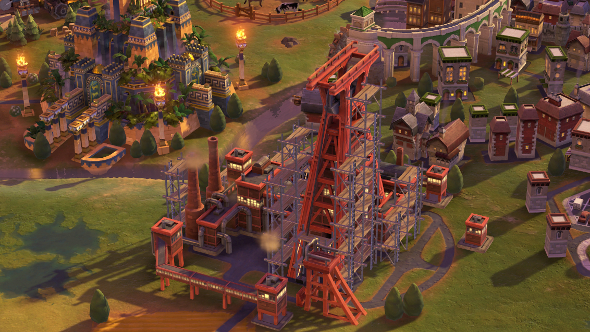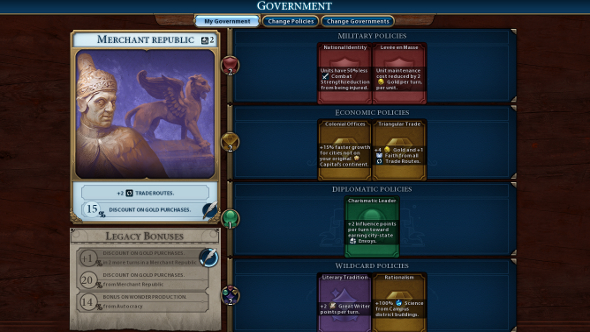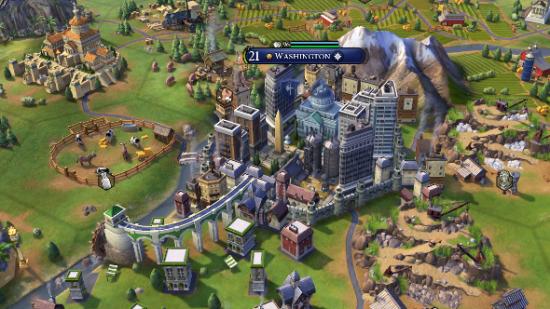With Civilization VI’s launch just around the corner, you might be giving yourself stress headaches in an attempt to figure out which civ to pick for your very first game. Unfortunately, I can’t help you with that. However! If you eventually come to a conclusion and that conclusion is: maybe America sounds good, then this is where our Civilization VI America guide might come in useful.
Yes, we’re putting the nation of Theodore Roosevelt, friend to bears, under the microscope. We’re going to get into America’s guts, taking a look at the civ’s special ability, unique units and buildings, and how you can make the most out of this faction and its chubby, mustachioed leader.
So you’re into tactical decisions and total domination? Why not try the best strategy games on PC?
- Looking for more general advice? Try our Civilization 6 strategy guide.
- Not sure which nation to pick? Our Civilization 6 leaders guide can help.
- Prefer the nuclear lord himself? See our Civilization 6 Gandhi guide.
- Learn the ways of veni, vidi, vici with our Civilization 6 Rome guide.
Teddy Roosevelt features

Awww, will you just look at him. Isn’t he just the most adorable of all the Presidents? The fact that he looks like some sort of man-bear-walrus hybrid makes Teddy pretty great right out of the gate, but what else does he bring to the table? Roosevelt corollary, that’s what. It’s his special ability, and it’s not what you’d perhaps expect from his cuddly exterior.
Roosevelt corollary
Roosevelt corollary is a bounty of handy gifts. First of all, there’s the Rough Rider unit, which is a modern cavalry unit unique to Roosevelt. It generates culture with every kill and gets a +10 combat bonus while fighting on hills. Compare it to the earlier cavalry unit from the industrial era, and you’ll notice a bump in melee strength from 62 to 67, or 77 on hills.
It’s an impressive unit that serves as an interesting alternative to the tank (note that it doesn’t replace the tank, so you can field both). Even when we compare a Rough Rider on a hill with a tank, the latter still has a little more firepower. It’s not always the size of your gun that counts, however. The Rough Rider has an advantage when it comes to movement, able to move five tiles to the tank’s four; has a third of the maintenance cost, a measly two gold; and, unlike the tank, requires no strategic resources to construct. You’re getting three Rough Riders for the maintenance cost of a single tank, and a lower production cost, making them a prime candidate for a corps, a group of the same units combined into a stronger one.
The Rough Rider’s bonuses go pretty well with the +5 combat bonus all American units receive while fighting on their home continent, which puts the Rough Rider up to +15 on hill tiles. It might not sound like a huge bonus, but it’s a unit-wide advantage and can prove the deciding factor in a close battle. In the early game, the bonus is also particularly handy when dealing with Barbarians.
Roosevelt corollary’s final feature is a +1 appeal to all tiles in a city with a national park. Appeal increases the number of homes that a neighbourhood district contains and will help you achieve a culture victory by generating tourism from seaside resorts, buildings that are powered by appeal.
American Empire features

Founding fathers
This ability cuts the amount of time it takes to get government legacy bonuses in half. Every government type has a legacy bonus that increases slowly as multiple turns pass. Communism’s legacy bonus is an increase in production, for example. The number you increased the original bonus by remains in effect even when you switch government.
Founding fathers, then, is a pretty powerful ability. You’re effectively getting double the legacy bonus. It’s worth sampling all the governments, but the ones to look out for in particular are oligarchy and fascism. The first, can be accessed after you research political philosophy in the civics tree, while the latter is a late game government. Take a look at the government section of this guide for more advice on governments suited to America.
P-51 Mustang
The P-51 Mustang is the American replacement for the Fighter, costing the same in production and maintenance. Where it differs from the Fighter is its higher melee strength of 85, compared to the Fighter’s 80, and its special ability. The P-51 gets an additional +5 attack against other Fighters, along with a +2 to movement range and a 50% experience bonus. Simply, the P-51 is a bit of a badass.
It is best used to hunt down and defeat modern enemy aircraft. Its stats and mobility make it a good all-rounder, taking on cities, infantry and tanks, but that extra attack against fighters makes it clear what it’s designed for. It even manages to hold its own against the more advanced information age jet, even though the latter’s base stats are higher. Unlike other fighters, the P-51 doesn’t use any strategic resources, either.
Film studio
The American version of the broadcast centre, the film studio is largely the same but has one rather significant extra ability. Like the broadcast centre, it generates +4 culture, +1 citizen slot, +1 great artist point per turn, +2 great musician points per turn, +1 great work of art, making it a pretty powerful cultural building. Unlike the centre, however, it also creates +100% tourism pressure from the city it’s built in toward all other modern era civs, encouraging their tourists to come and check out the hip and happening American Empire.
Like the appeal bonus from Roosevelt corollary, the film studio will help you work towards a culture victory, along with other culture and tourism generating buildings like museums, amphitheatres and the theatre district.
America – victory goals

At a glance, a domination victory seems natural for a civ with unique and powerful military units and that +5 attack bonus from Roosevelt corollary. But to win through domination, you need to conquer every other civ’s capital – no mean feat when you’ve got continents to cross and multiple empires getting rowdy.
As mentioned earlier, America also has buildings and an ability that imply a cultural leaning, making a culture victory another very viable path. Both require very different wonders, governments and policies, so it’s worth making a decision on which path to follow early. That said, you’re not forced to focus, and tourism in particular – key to a culture victory – doesn’t really come into play until the modern era, giving you plenty of time to explore other potential avenues.
America – wonders

Wonders, many of which are now unlocked in the civics tree, can augment your civilization with significant buffs, resources and new units. They enhance all aspects of your empire, but there’s a clear prevalence of culture wonders.
Would-be conquerors seeking to take over the world should invest in the Terracotta Army wonder and the Alhambra. The former immediately promotes every one of your units, while generating great general points, eventually making a special unit available that might create new units, build a fort, or support your other units. Alhambra permanently adds an extra military policy slot to every government, and generates two points every turn toward a great general.
There are few military-specific wonders, but those like the Rhur Valley are worth constructing for the increased production they generate. The Rhur Valley, specifically, enhances production in that city by 30%, with an extra +1 for every mine and quarry in the city. This greatly increases the speed with which you can spew out new units.
If you’re going down the culture path instead, you’re spoiled for choice. The first is the Pyramids, which generates +2 culture and gives you a free builder unit, but the civics tree offers up significantly more powerful wonders. The Colosseum, for example, adds +2 culture to not just the city it’s located in, but any others that are within six tiles. Later game wonders like Broadway and the Sydney Opera House, with all their great writer and musician points and new slots for great works of art are massive boons for tourism civs.
Even if you’re heading down the domination or culture route, you should still explore other wonders. Anything that speeds up growth or fills your pockets with cash is going to be handy no matter what victory goal you’ve picked.
America – governments

Civilization VI has six types of governments, not including the starting and largely rubbish government of chiefdom, unlocked via the civics tree. Governments are made up from a mix of policy slots, split up into military, economic, diplomacy and wildcard. As you work your way down the civics tree, you’ll unlock more policies to add to a government’s limited slots.
As previously discussed, oligarchy and fascism are attractive government types for the military-minded leaders. Oligarchy has an inherent bonus, one that doesn’t transfer over when you change government, that increases the strength of land melee units by 4 and a legacy bonus that gives all combat units more experience. Fascism contains the greatest number of military policy slots, giving you more ways to fine-tune your military, and inherent bonus of +4 combat strength to all units, and a legacy bonus that increases unit production.
Those are early and late game governments, however, so what government should you choose between them? There’s nothing as overtly militant, which would have been a plus given America’s focus on its combat units, but monarchy has the most military policy slots. However! If you’re generating a lot of faith through holy sites, but not spending it on missionaries, theology might be a good government if you want to build an army. With theology, you can buy land units with faith along with a legacy discount for faith purchases.
None of the governments are distinctly cultural in nature, so the choices aren’t as clear if that’s your victory goal of choice. There are three that have bonuses that are tangentially related to this path, however.
Classical republic has a legacy bonus that increases the number of points your civilization generates toward great people, so you’re likely to get great musicians, artists and writers faster, and their creations will give you more culture and tourism points. Merchant republic’s inherent bonus expands the number of trade routes you can have running, in turn increasing the potential amount of culture you can get through trade. Finally, democracy’s inherent bonus makes buying great people 50% cheaper. These governments generally have more wildcard slots, as well, and wildcards are all tied to great people.
America – policies

Civilization VI contains around 70 policies, from the simple ones that make keeping units cheaper, to the more situational that give you 50 gold per appeal of a farm tile being replaced by a neighbourhood. Whenever your civilization makes a big civic advancement, you can change the policies that have been slotted into the government. You can also pay a fee to customise them at any time.
If you’re feeling a bit bloodthirsty, then you’ll want to use a lot of military policy cards. The aforementioned unit maintenance card ‘Conscription’ and its more powerful variant ‘Levee en Masse’ are must-haves if you’re going to be fielding a lot of units. The first is available early on, as well, which is a nice bonus. There are several cards that increase production toward units belonging to specific eras, and should be employed whenever you’re planning to expand your army.
Policies benefiting a culture-focused civ tend to be economic cards, like ‘Market Economy’, which provides +2 culture (as well as +2 science and +1 gold) for every international trade route. Meritocracy is another desirable policy, as it adds +1 culture to each city for every specialised district. This card really comes into its own when you start managing large, eight-district cities.
Ultimately, you’ll be swapping them around a lot, dealing with different crises or necessities as they arise. There’s no perfect loadout, as it’s designed to be reactive, letting you make changes whenever you need to.
While America and Roosevelt’s abilities make them comfortably fit into the role of conqueror or cultural powerhouse, there’s nothing stopping you from focusing on space travel and scientific accolades or taking over the world with religion instead. While America lacks unique features that give it a scientific or religious edge, buildings, improvements and citizen management can shore up any gaps.
